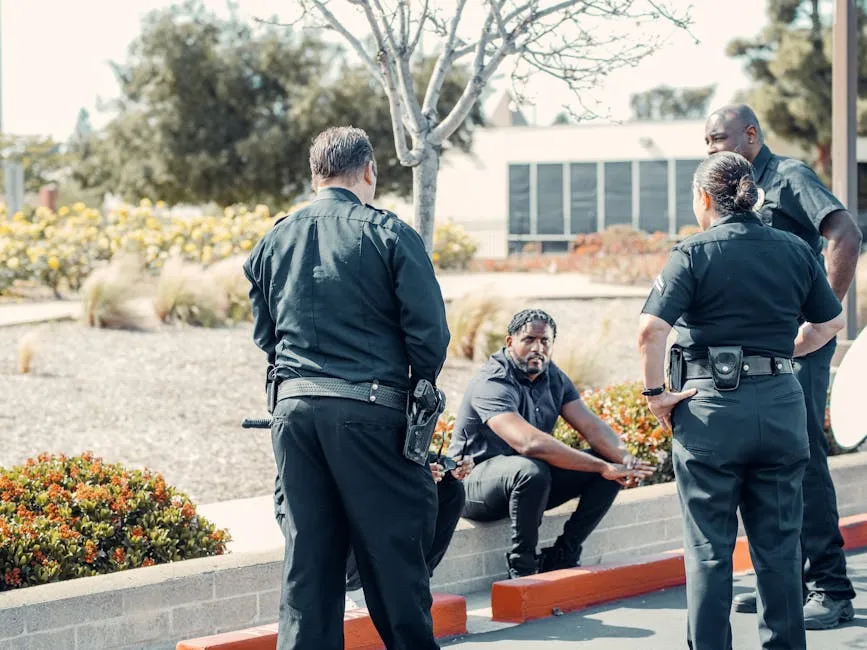Introduction
When we think about community safety, crime statistics pop to mind like toast popping out of a toaster—often unexpected and sometimes alarming. Understanding these numbers is crucial for residents, policymakers, and anyone looking to enjoy the charm of Annapolis without unwarranted worries.
This article aims to shine a spotlight on Annapolis crime statistics, revealing trends and comparisons with national averages. Our goal? To provide a thorough overview that can help you grasp the safety landscape of this beautiful city.
We will break down specific crime types, explore historical trends, and offer local perspectives. By the end of this read, you will be armed with insights that could influence your daily life in Annapolis. So grab your coffee, and let’s dig into the details!
While you’re at it, consider securing your home with a Home Security Camera System. It’s like having a digital watchdog that never sleeps, giving you peace of mind while you enjoy that coffee!

Understanding Crime Statistics
What are Crime Statistics?
Crime statistics are numerical representations of crime occurrences in a specific area. They include data on various offenses, helping us gauge public safety. Think of them as a report card for community safety—showing us how well we are doing or where we can improve.
Crime statistics can generally be classified into two categories: violent crimes and property crimes.
Violent crimes involve force or the threat of force. They include offenses such as murder, rape, robbery, and aggravated assault. These incidents can have lasting effects on victims and communities, instilling fear and anxiety.
Property crimes, on the other hand, are about taking someone else’s belongings without the use of force. This category includes burglary, theft, and motor vehicle theft. While they may not seem as dire as violent crimes, property crimes can still disrupt lives and communities.
To ensure your belongings are safe, consider investing in a Door Lock Security System. It’s like having a bouncer for your home that doesn’t take breaks!

The Role of Law Enforcement
Law enforcement agencies play a pivotal role in collecting and reporting crime data. They actively gather information on reported crimes, which is then compiled and analyzed. The FBI’s Uniform Crime Reporting (UCR) Program is instrumental in this process, providing a standardized framework for tracking crime across the nation.
The UCR collects data from law enforcement agencies, creating a comprehensive picture of crime trends. This program helps law enforcement and the public understand crime’s landscape and focuses efforts on enhancing safety. Each year, thousands of law enforcement agencies contribute to this vital data set, shaping our understanding of crime in cities like Annapolis.
In summary, crime statistics are not just numbers; they are critical tools that help us understand community safety and the effectiveness of local law enforcement. Armed with this knowledge, residents can make informed decisions about their safety and the safety of their neighborhoods.

Overview of Annapolis Crime Statistics
Current Crime Rates
Annapolis, Maryland, is a charming city, but it has its share of crime. With a total population of approximately 40,648, the city recorded 1,023 reported crimes in 2022. This translates to a crime rate of about 25.17 incidents per 1,000 residents.
Violent crimes account for 231 of these incidents, while property crimes make up the remaining 792. So, if you’re thinking of becoming a statistic, your chances of falling victim to a violent crime are roughly 1 in 176, while property crimes present a higher risk of 1 in 51.
Let’s break down the specific offenses. The violent crime statistics paint a mixed picture:
- Murder: 1 incident (0.02 per 1,000 residents)
- Rape: 18 incidents (0.44 per 1,000 residents)
- Robbery: 42 incidents (1.03 per 1,000 residents)
- Assault: 170 incidents (4.18 per 1,000 residents)
On the property crime front, things look like this:
- Burglary: 75 incidents (1.85 per 1,000 residents)
- Theft: 647 incidents (15.92 per 1,000 residents)
- Motor Vehicle Theft: 70 incidents (1.72 per 1,000 residents)
These figures suggest that while violent crime is relatively low, property crime, particularly theft, poses a significant challenge for the community. To combat this, consider having a Smart Doorbell Camera. It’s like having a butler who also takes security very seriously!

Year-over-Year Trends
When we peek into the crime trends over the last decade, a clearer picture emerges. Crime rates in Annapolis have undergone fluctuations, but recent years have shown a notable decline. From 2021 to 2022, overall crime decreased by around 14.7%.
Focusing on violent crimes, the numbers have generally trended downward, with reports of murder dropping significantly in recent years. For instance, the number of murders fell from 6 in 2020 to just 1 in 2022. Rape and robbery incidents have also seen a decrease, while assault rates have remained somewhat stable.
Property crimes, however, have fluctuated more dramatically. While burglary rates have diminished, theft continues to be a concern. The community has made strides in addressing these issues, but there’s still work to be done, especially in tackling property crimes.
Comparison with State and National Averages
Now, let’s see how Annapolis stacks up against Maryland and national averages. When comparing crime rates, Annapolis shows a violent crime rate of 530 per 100,000 residents, which is significantly higher than the national average of 370. However, this figure is still lower than many Maryland cities, which often report rates above 800.
In terms of property crime, Annapolis records 1,944 per 100,000 residents, mirroring the national average closely. This means that while violent crime is a bigger issue in Annapolis, property crimes are more in line with what you’d find across the country.
These comparisons highlight that Annapolis, while facing challenges, is not an outlier. It sits comfortably in the middle range among cities in Maryland. Residents can take solace knowing that while crime does occur, it remains manageable compared to other areas.
In summary, Annapolis has a complicated relationship with crime. Awareness and proactive measures are essential for community safety. By understanding the statistics, residents can take informed steps to protect themselves and contribute to a safer environment for all.

Detailed Breakdown of Crime Types
Violent Crimes
Overview
Violent crimes are like the bad apples in the bunch. They involve force or the threat of force, and they can shake a community to its core. These crimes include murder, rape, robbery, and aggravated assault. When violent crimes rise, residents often feel less safe, leading to increased anxiety and community distress. Understanding these incidents helps local authorities create effective strategies to counteract their impact on community safety.
Statistics
In Annapolis, the violent crime landscape is nuanced. The city reported 231 violent crimes in 2022, translating to a violent crime rate of 5.68 per 1,000 residents. Let’s break this down further:
- Murder: 1 incident, which is notably low.
- Rape: 18 incidents, showing a rate of 0.44 per 1,000 residents.
- Robbery: 42 incidents, translating to 1.03 per 1,000 residents.
- Assault: A significant portion with 170 incidents, resulting in a rate of 4.18 per 1,000 residents.
While the murder rate might raise eyebrows, it remains low compared to many urban areas. However, the assault and robbery rates indicate areas for concern. For a deeper understanding of assault statistics, you can check out the campus sexual assault statistics.

Neighborhood Analysis
Not all neighborhoods are created equal when it comes to violent crime rates. Areas like Eastport and downtown Annapolis often report higher incidents of violent crimes. This isn’t just a statistic; it affects the daily lives of residents.
Community efforts are in place to combat these issues. Programs like neighborhood watch groups and local initiatives to increase public safety awareness help foster a sense of unity. The Annapolis Police Department also emphasizes community engagement, encouraging residents to report suspicious activities. Together, these initiatives aim to lower violent crime rates and enhance overall community safety.
Property Crimes
Overview
Property crimes are often seen as less alarming than violent crimes, but they can still disrupt lives significantly. These offenses include burglary, theft, and motor vehicle theft. The emotional toll on victims can be profound, and the financial repercussions can linger long after the incident. Understanding property crimes helps residents take preventive measures to safeguard their belongings.
Statistics
In Annapolis, property crime is more prevalent than violent crime, with 792 reported incidents in 2022. This results in a property crime rate of 19.48 per 1,000 residents. Here’s how it breaks down:
- Burglary: 75 incidents, translating to 1.85 per 1,000 residents.
- Theft: A staggering 647 incidents, equating to 15.92 per 1,000 residents.
- Motor Vehicle Theft: 70 incidents, resulting in a rate of 1.72 per 1,000 residents.
Theft, particularly, emerges as a significant concern. Residents need to remain vigilant and consider implementing additional security measures. A great option would be to get a Outdoor Security Camera with Night Vision. It’s like having a night owl that watches over your property!

Neighborhood Analysis
When we analyze property crime rates by neighborhood, certain areas such as the downtown district report higher occurrences. This can often be attributed to increased foot traffic and tourist activity.
Community programs, like local safety workshops and partnerships with law enforcement, aim to reduce these property crimes. The Annapolis Police Department actively engages residents in educational initiatives about crime prevention, urging them to secure their homes and vehicles. Through these collaborative efforts, the city hopes to foster a safer environment for all.
In summary, while Annapolis boasts a rich history and vibrant community, it’s essential to stay informed about crime trends. By understanding the types of crimes occurring in their neighborhoods, residents can take proactive steps toward enhancing their safety and that of their fellow community members.

Local Perspectives on Crime
Community Sentiment
Annapolis residents have a unique perspective on safety. Recent surveys reveal a mixed bag of feelings about crime in the area. In one survey, 63% of respondents felt pretty safe, despite acknowledging some concerns. About 25% declared they felt very safe, while 13% admitted to feeling somewhat uneasy.
This disparity between feelings and facts is intriguing. While crime statistics show a relatively low rate of violent crime, residents often perceive their surroundings as less secure than the numbers suggest. For instance, the violent crime rate in Annapolis stands at 5.68 per 1,000 residents while property crime rates soar to nearly 19.48 per 1,000.
So why the disconnect? Well, it often boils down to personal experiences and media portrayals. When crime does occur, it tends to dominate headlines and social media feeds, amplifying fears. This illustrates that perceptions can sometimes outweigh actual statistical risks. With a crime rate of 25.17 per 1,000 residents, it’s essential for residents to contextualize these numbers. They should weigh the facts against their feelings for a more balanced view of safety in Annapolis.
To enhance personal safety, consider carrying a Personal Safety Alarm Keychain. It’s a small device that can make a big noise when you need help!

Law Enforcement’s Role
The Annapolis Police Department plays a crucial role in shaping community perceptions about safety. Survey responses indicate that 61% of residents view local law enforcement as very visible and responsive. Yet, some residents believe police response times could improve, with 19% expressing concerns about delays when needed.
Community-police partnerships have blossomed in Annapolis. These collaborations aim to foster trust and improve safety. Programs such as neighborhood watch groups and community policing initiatives are designed to bridge the gap between law enforcement and residents.
Engagement activities, like community forums and safety workshops, allow residents to voice concerns and share insights. This open communication helps the police better address community needs. Crime prevention strategies become more effective when residents partner with law enforcement.
In summary, while feelings of safety among Annapolis residents vary, the commitment of local law enforcement to engage with the community remains steadfast. These partnerships are key to improving perceptions and ensuring a safer Annapolis for all.

Resources for Residents
Crime Prevention Programs
Annapolis offers several initiatives aimed at reducing crime and enhancing community safety. One notable program is the Neighborhood Watch, where residents band together to monitor and report suspicious activities. This proactive approach fosters vigilance and enhances neighborhood bonds.
Another key initiative is the Annapolis Police Department’s Community Crime Prevention Program. This program provides residents with practical safety tips, home security assessments, and crime trend updates. Residents can participate by attending workshops and training sessions designed to empower them with knowledge.
Additionally, the city promotes collaboration with local organizations to address issues like drug abuse and youth violence. Events such as community clean-ups and safety fairs not only beautify neighborhoods but also build trust and camaraderie among residents. If you’re looking to be prepared for emergencies, consider putting together an Emergency Preparedness Kit. You never know when it might come in handy!

For those interested in participating, attending community meetings is a great start. Residents can find information about upcoming events and programs on the Annapolis city website or through local social media channels.
By engaging in these crime prevention initiatives, Annapolis residents can contribute to a safer environment and become active participants in their community’s well-being.
Reporting Crimes
Reporting crimes is crucial for maintaining community safety. It’s like a neighborhood watch, but digital! Residents must be proactive and vigilant. An accurate crime report helps law enforcement respond effectively. Plus, it aids in identifying crime trends, which can lead to better prevention strategies.
Residents can report crimes in several ways. The Annapolis Police Department encourages direct reporting through their official channels. If you witness a crime or suspicious activity, don’t hesitate to reach out! You can call 911 for emergencies. For non-emergencies, dial 410-268-9000.
Additionally, the Annapolis Police Department offers an online reporting system for certain incidents. This user-friendly option allows residents to file reports from the comfort of their homes.
For more information on crime statistics, reporting mechanisms, and community safety initiatives, visit the Annapolis Police Department’s website. Remember, your involvement helps create a safer Annapolis for everyone!

Conclusion
Understanding crime statistics is essential for community safety. This article has explored Annapolis crime trends, revealing both challenges and successes. The data highlights that while violent crimes are relatively low, property crimes, particularly theft, remain a significant concern.
By staying informed, residents can take proactive measures to protect themselves and their neighborhoods. Knowledge is power! Engage with local law enforcement and participate in community initiatives aimed at crime prevention.
As we wrap this up, remember that safety is a shared responsibility. Encourage your neighbors to stay informed and vigilant. When communities come together, they can foster a safer environment for all.
So, keep those eyes peeled and report anything suspicious. Together, we can ensure Annapolis remains a charming, safe place to live, work, and play. And don’t forget to keep a First Aid Kit for Home and Travel handy. Because you never know when you might need it!

FAQs
What should I do if I become a victim of crime in Annapolis?
If you become a victim, stay calm and follow these steps: 1. Ensure your safety first. Move to a secure location. 2. Call 911 immediately for emergencies or serious crimes. 3. If safe, gather information about the incident, such as location and suspect descriptions. 4. Report the incident to the Annapolis Police Department. Use the non-emergency number (410-268-9000) for less urgent matters. 5. Document everything. Write down details and save any evidence. 6. Seek support. Talk to friends, family, or professionals about your experience.
How can I find out more about crime in my neighborhood?
To learn more about crime in your area, check these resources: – Local Crime Maps: Websites like NeighborhoodScout provide interactive crime maps. – Community Forums: Join neighborhood groups on social media platforms to discuss safety concerns. – Annapolis Police Department: Visit their website for the latest crime statistics and reports.
What is the role of the Annapolis Police Department in crime prevention?
The Annapolis Police Department plays a vital role in crime prevention through: – Community Engagement: They build trust through outreach programs, safety workshops, and neighborhood watch initiatives. – Crime Data Analysis: By analyzing crime trends, they focus resources on high-risk areas. – Public Education: The department provides safety tips and resources to residents, empowering them to protect themselves.
How often are crime statistics updated?
Crime statistics are updated annually by the Annapolis Police Department. The latest data is usually released in the fall, reflecting the previous year’s activities. For the most current information, check their official website.
Are there specific neighborhoods in Annapolis that are safer than others?
Yes, some neighborhoods in Annapolis report lower crime rates. Areas like Bay Ridge and Epping Forest typically experience fewer incidents compared to downtown or Eastport. It’s essential to stay informed about local trends and engage with community safety initiatives to enhance security in all neighborhoods.
Please let us know what you think about our content by leaving a comment down below!
Thank you for reading till here 🙂
All images from Pexels




